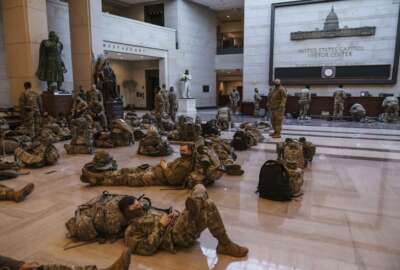
Pulling troops from Afghanistan is easy — everything else, not so much
The U.S. withdrawal from Afghanistan comes with huge logistical and contracting challenges. Getting the troops on planes or ships, that's the easy part.
Best listening experience is on Chrome, Firefox or Safari. Subscribe to Federal Drive’s daily audio interviews on Apple Podcasts or PodcastOne.
The U.S. withdrawal from Afghanistan comes with huge logistical and contracting challenges. Getting the troops on planes or ships, that’s the easy part. With details of what the government and its contractors actually face in fulfilling the Biden administration’s new policy, Federal Drive with Tom Temin turned to Bloomberg Government reporter Roxana Tiron.
Interview transcript:
Tom Temin: Roxana, you have done some pretty detailed work on this. And let’s start with how many people are involved in the contracting workforce.
Roxana Tiron: So the Defense Department alone, so we’re not talking about other agencies in the US government. The Defense Department alone has 16,832 workers employed by contractors in Afghanistan, of whom 6,147 are US citizens. And to put that into context, that’s more than double the remaining 2,500 US troops in Afghanistan. Contractors in Afghanistan to support the military with everything from lodging, laundry, food, transportation, equipment, maintenance and fuel.
Tom Temin: So they have to kind of be there to close the door so to speak, after the troops withdraw.
Roxana Tiron: More or less. The Pentagon on has been saying that some of the contractors are going to start flying out. So the US withdrawal is actually starting, that’s a new mission. The US is concentrated on trying to get the forces out. That’s the primary mission of the US troops in Afghanistan, and the Pentagon is planning to take some of the contractors with them. The rest, however, are still waiting for marching orders to know when to leave the country. What’s going to happen to the contract, whether they’re needed elsewhere in the region.
Tom Temin: Sure. And if contractor employees do return home, who pays for that? All the logistics of getting them home, the Pentagon or the companies themselves?
Roxana Tiron: I think it’s a combination. I’m sure the Pentagon they plan for various contingencies, right. So I think mostly, it will be part of a contract that may have to be re-discussed, renegotiated. We’re not able to see the terms of the contracts to be clear, but that is probably built in in terms of costs.
Tom Temin: And speaking of the contracts, just give us a sense of how much has been spent there over the years. And you’ve looked at the last six months or so of spending. And these are big numbers.
Roxana Tiron: Right. So since 2002, the Pentagon has spent basically $108 billion on contracted services in Afghanistan. And this is based on the data we have a Bloomberg Government. Some of the largest vendors with the Pentagon in Afghanistan are Flour Corporations, they have about $3.1 billion spent on a contract with floor between 2016 and January 2021, they spent about 3.1 billion, and then Amentum Parent Holdings has about another $1.7 billion during the same period. These are logistics civil augmentation program. It’s basically an indefinite delivery and quantity contract given in multiple awards. Like I said at the beginning, they take care of everything from logistical support from maintenance of equipment to service for the troops — lodging, feeding, a lot of equipment maintenance, air traffic control, airfield upkeep on an aircraft operations and maintenance. So it’s a wide range of contracted services that these companies have.
Tom Temin: We’re speaking with Roxana Tiron, she’s a national security reporter for Bloomberg Government. And let’s talk about the removal of the equipment that the United States deems that it wants back. I remember back in the major Iraq withdrawal, just billions of dollars of junk left behind because it was too expensive to bring it home or rehabilitated. The waste is almost hard to look at when it comes to the numbers here. But what about Afghanistan? Do we have any sense of what contractors will be needed to do to get helicopters, tanks, whatever they have over there, back to the United States?
Roxana Tiron: Not yet actually, we don’t know exactly how they’re gonna do it. The Pentagon has been pretty tight lipped about the plans as far as contractors are concerned. But as you know, Afghanistan is landlocked, so a lot of it will have to transition through the region and then a lot of it is also going to go by ship back to the United States. So it’s not an easy logistical feat. And as you know, a lot of equipment is likely to stay in Afghanistan, probably joined the boneyard, with the Russian equipment from the 80s.
Tom Temin: But even in that case, you have to prepare it for the boneyard. You can’t leave sensitive electronics in it, or whatever else might be of value to some enemy that would swoop in about 10 minutes after you leave to start picking it apart.
Roxana Tiron: Right. So we don’t actually have any of those details yet. And I know that there’s been a lot of concern about the Afghanistan Air Force because we obviously have spent a tremendous amount of money and we’ve sent Blackhawk helicopters to Afghanistan which needs some significant maintenance and training for the Afghan forces. And so that has been a big concern in terms of who stays behind. There’s been some hints at potentially doing maintenance by Zoom with some of these aircraft. So it seems to me that the preparation for how to handle the equipment, how to get it off the country, what you keep in there, it’s just at the beginning stage, or at least it’s not made public.
Tom Temin: I can just see it by Zoom, count back 16 rivets and then move up four rivets and there’s a little panel there, take off that rivet and blah, blah, blah.
Roxana Tiron: The pandemic has taught us a lot and potentially aircraft maintenance by videoconference.
Tom Temin: Sure. And looking at where Afghanistan is, of course, you’ve got two choices to get the stuff out. It’s not going to go through Iran, so it’s going to have to go through Pakistan. And so we’ll take some cooperation from that country also.
Roxana Tiron: Yes, exactly. And also, General McKenzie, the head of the Central Command, has been talking about how the US is trying to get some basic agreement with other countries in the regions, potentially the stan countries, but the US has no agreements yet. So a lot of the movement, a lot of where you base some of the counterterrorism units, where you base some of the equipment, some of the logistical support that comes with that has not been determined yet. Some of it might stay in the region and be there with our troops. But we don’t know yet where that’s going to be.
Tom Temin: Well, we do know that in other countries, old leftover military gear as it rusts turns into some beautiful material for artwork.
Roxana Tiron: Yes, for sure. I’ve talked to a lot of people who have served in Afghanistan who watched with it all very closely. And the expectation is that we are going to leave a lot of equipment behind.
Tom Temin: Roxana Tiron is a national security reporter with Bloomberg Government. Thanks so much.
Roxana Tiron: Thank you. Thanks for having me.
Copyright © 2025 Federal News Network. All rights reserved. This website is not intended for users located within the European Economic Area.
Tom Temin is host of the Federal Drive and has been providing insight on federal technology and management issues for more than 30 years.
Follow @tteminWFED
Related Stories





